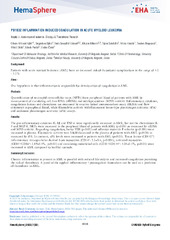| dc.creator | Mitrović Ajtić, Olivera | |
| dc.creator | Đikić, Dragoslava | |
| dc.creator | Suvajdžić-Vuković, Nada | |
| dc.creator | Mitrović, Mirjana | |
| dc.creator | Subotički, Tijana | |
| dc.creator | Vukotić, Milica | |
| dc.creator | Dragojević, Teodora | |
| dc.creator | Diklić, Miloš | |
| dc.creator | Pantić, Nikola | |
| dc.creator | Čokić, Vladan | |
| dc.date.accessioned | 2024-01-29T13:20:32Z | |
| dc.date.available | 2024-01-29T13:20:32Z | |
| dc.date.issued | 2023 | |
| dc.identifier.issn | 2572-9241 | |
| dc.identifier.uri | http://rimi.imi.bg.ac.rs/handle/123456789/1425 | |
| dc.description.abstract | Background: Patients with acute myeloid leukemia (AML) have an increased risk of thrombotic complications in the range of 4.2 - 5.2%.
Aims: Our hypothesis is that inflammation is responsible for deterioration of coagulation in AML.
Methods: Quantification of neutrophil extracellular traps (NETs) from peripheral blood of patients with AML by measurement of circulating cell-free DNA (cfDNA) and myeloperoxidase (MPO) activity. Inflammatory cytokines, coagulation factors and chemokines are measured by enzyme-linked immunosorbent assay (ELISA) and flow cytometry in peripheral blood, while fibrinolytic activity with fluorescent tissue-type plasminogen activator (tPA) and urokinase plasminogen activator (uPA) assays.
Results: The pro-inflammatory cytokines IL-1β and TNF-α were significantly increased in AML, but not the chemokines IL-8 and MCP-1. NETs were increased in the peripheral blood of patients with AML (p<0.05) as measured by cfDNA and MPO activity. Regarding coagulation, factor VIII (p<0.05) and adhesion molecule P-selectin (p<0.001) were increased in plasma. Fibrinolytic activity was 3-fold decreased in the plasma of patients with AML (p<0.01) as measured by tPA. In contrast, uPA levels were increased in patients with AML (p<0.05). Tissue factor (CD142+) inflammatory microparticles derived from monocytes (CD14+: 5.1±0.6, p<0.001), activated monocytes (CD14+/CD16+: 2.89±0.4%, p<0.05) and circulating endothelial cells (CD31+/CD144+: 4.08±0.5%, p<0.05) were increased in AML compared to healthy controls.
Summary/Conclusion: Chronic inflammation is present in AML in parallel with reduced fibrinolysis and increased coagulation provoking the risk of thrombosis. A panel of the applied inflammatory/ procoagulant biomarkers can be used as a predictor of thrombosis in AML. | sr |
| dc.language.iso | en | sr |
| dc.publisher | Wolters Kluwer Health, Inc. | sr |
| dc.rights | openAccess | sr |
| dc.rights.uri | https://creativecommons.org/licenses/by-nc-nd/4.0/ | |
| dc.source | HemaSphere - EHA2023 Hybrid Congress Abstract Book | sr |
| dc.title | PB1832: Inflammation induced coagulation in acute myeloid leukemia | sr |
| dc.type | conferenceObject | sr |
| dc.rights.license | BY-NC-ND | sr |
| dc.citation.issue | S3 | |
| dc.citation.spage | 68019.6f | |
| dc.citation.volume | 7 | |
| dc.identifier.doi | 10.1097/01.HS9.0000974172.68019.6f | |
| dc.identifier.fulltext | http://rimi.imi.bg.ac.rs/bitstream/id/3338/Inflammation_induced_coagulation_conf_2023.pdf | |
| dc.type.version | publishedVersion | sr |

